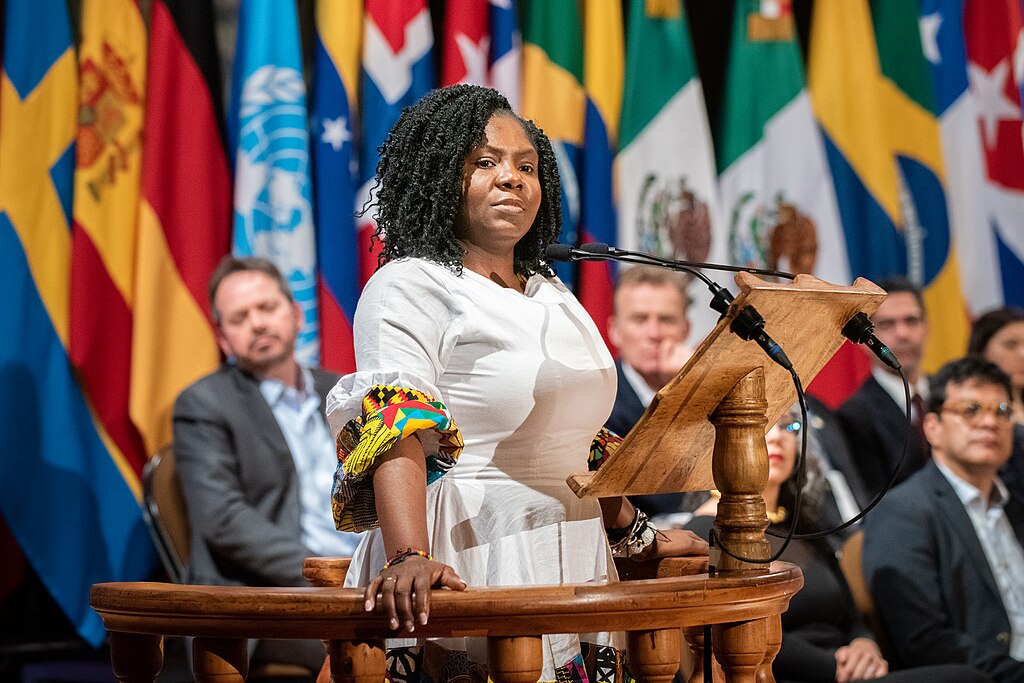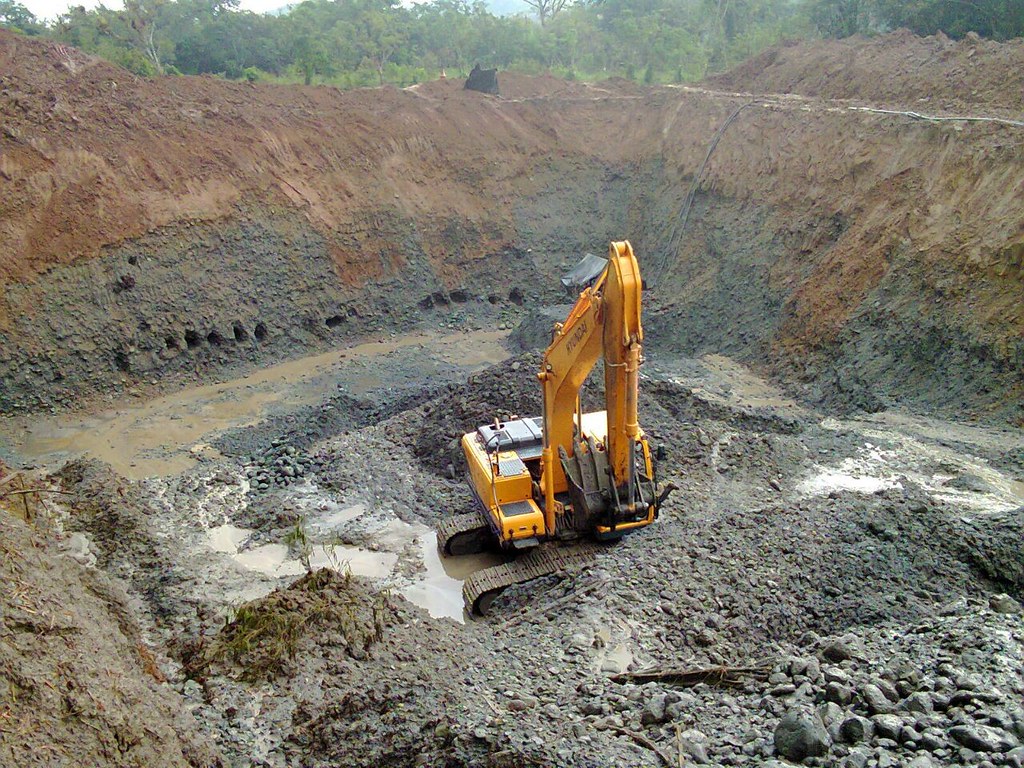
In this post, I spotlight how Black women advocate for human, territorial, and environmental protection through political performances. Moreover, I explore how the legacies of capitalism and colonialism have not only accelerated environmental degradation, but also disproportionately impacted Black populations and continued to shape the Black experience in contemporary Colombia. Lastly, I underscore how dispossession is not merely a matter of losing land and territory but is also a violation of the individual body and collective body.
Although Black Colombians were declared the legal proprietors of ancestral lands, territories, and natural resources according to Law 70 of 1993, private companies, guerrilla groups, and paramilitary groups (amongst others) have continued to dispossess land, displace Blacks, as well as practice illegal mining and dump mercury into rivers. While many have been displaced, others have been forced to endure the poisoned waters. In effect, inhabitants of the Pacific coast have ingested lethal amounts of mercury, and it has even been found in mothers’ breast milk. This led Goldman Prize winner Francia Marquez, who would become Colombian Vice President in 2022, to declare this a “generational genocide.” The Pacific Coast is the region where the majority of rivers in the country begin. As a result of the informal mining, more than eighty rivers are contaminated in Colombia. Thus, sectors participating in illegal mining are not only violating environmental and territorial rights, but also the human and civil rights of Black Colombians. Despite legal rights, sociologist Tiana Paschel highlights that in Colombia “there is a notorious gap between laws on paper and actual state practices” (189). Consequently, in 2019, according to the United Nations, two-thirds of the gold produced in Colombia was illegally extracted. Much of this gold was extracted from Black and Indigenous communities like the Pacific Coast, which is meant to be protected under Law 70.
These injustices do not go unchallenged. Black women are at the forefront of resistance to these practices and in pushing for human, territorial, and environmental protection. Black women in the Pacific Coast are defending not only water (be it freshwater or saltwater), but also land and territories. The protection of water sources like rivers is particularly important as they sustain life, provide routes for transportation, and contribute to the landscape and waterscape of ancestral and spiritual territories. Moreover, the protection of land and territories allows people to perform cultural practices, produce life, affirm identity, and much more.
Black women have been at the forefront of authoring pathways to futurity through their care work, spiritual customs, performance cultures, aesthetic practices, philosophies, and activist movements.
Thinking alongside Axelle Karera’s “Blackness and the Pitfalls of the Anthropocene,” I illuminate how various “regimes of Anthropocenean consciousness” tend to mobilize apocalyptic events to promote ahistoric unities that elide the daily and historic catastrophes of Black life (32).[1] If the institution of slavery is to be used as a temporal anchor for examining Black life in the Americas, then we see that Black women have been at the forefront of authoring pathways to futurity through their care work, spiritual customs, performance cultures, aesthetic practices, philosophies, and activist movements. The Black women of Colombia are no exception to this.
The March of Turbans
In 2014, La Marcha de los Turbantes, or the March of Turbans, as mass media termed it, was led by Francia Marquez. During this march, more than eighty Black women marched on foot from the Pacific coast of Colombia to the capital city of Bogotá in demand for land and water rights. And as the name infers, they all adorned their heads with headwraps or turbans. Black women, throughout history, have not only been integral components and leaders of social movements, but also, as historian and cultural theorist Tanisha Ford emphasizes, “have incorporated beauty and fashion into their activism” (3). Black women’s activism is unique and particular because undoing, challenging, and re-aestheticizing Black women through activism is something that only Black women have the positionality to fulfill. Black women have long included performances of aesthetic practices, including how they dress and style their hair, as a component of activism to not only contribute to the social movement at hand, but to also resist societal norms that have historically been structured to oppress Black women; for instance, the archetype of mammy, their representation as laborers, and/or as people who belong in positions of servitude, amongst others. Historically, in Colombia, as well as many parts of Latin America, headwraps were required for Black women during and following the years of enslavement. Throughout history, and even today, turbans are a component of some uniforms for positions of servitude. However, with the natural hair movement, Black women often wear headwraps as crown of pride and a symbol of identity. Furthermore, to wear headwraps during the march was a decision that reflected a desire to demonstrate pride in their African ancestry and to resist the norm of being a mammy, caregiver, and laborer. This simultaneously allowed them to take up the ever-present, yet often unrecognized normative position of being political thinkers and agents of change.

The march lasted ten days as they journeyed 350 miles to the capital to demand the total elimination of all illegal miners and equipment from their coastal community, which were present without communal consent. Their demands were two-tiered: First, they wanted to denounce illegal mining; and second, they wanted to advocate for policies and laws that protect the environment and the people impacted by illegal mining. Once in Bogotá, the women stated that “we will not move from here until the government removes the last dozer from our lands.” Many of the women during the March of Turbans explained that illegal mining, which compromises water sources, is not only an instance of historical and ancestral devastation, but also a threat to the future. Countless Blacks on the Pacific coast still heavily rely on access to land, natural water, and the independent collection of gold for social security. Contaminated water sources and the hyper extraction of gold are not only a direct threat to the current residents, but also alter the possibility of future generations to live and thrive in ancestral territories.
The Loss of Land and the Loss of Self
Another reality challenging Blacks from living and thriving in ancestral territories is dispossession. Blacks have been forcibly displaced from (and dispossessed of) their ancestral lands and territories through decades of internal conflicts and illegal mining. Nonetheless, dispossession is not only a matter of losing land and/or territory, but it is also a violation of the individual body and collective body. Political theorist Robert Nichols explains that with dispossession, “the primary locus of concern is not land but the body, self, or person.” He goes on to clarify that “the term dispossession is used to describe a particular violation of personal autonomy and/or bodily integrity” (118). Moreover, given that Blacks in the Pacific Coast of Colombia have ancestral, spiritual, economic, and other connections to the land and territory, they are part of the environmental ecology. The African philosophy Ubuntu, which means “soy porque somos” or “I am because we are,” has helped inform how Black identity is formed not only in relation to the land and water, but also as part of the wider ecology. “Being part of” then implies a recognition of the “interdependence” that shapes the Black experience and makes life possible (85). Francia Marquez has rooted her activism in this philosophy in her fight for human and environmental rights. In doing so, she highlights how Blacks have a collective and individual identity that is embedded in the earth, territory, and environment. Max Liboiron explains this interdependence with the earth, or what they consider Land (capitalized). “Land is a spiritually infused place grounded in interconnected and interdependent relationships, cultural positioning, and is highly contextualized … when I capitalize Land I am referring to the unique entity that is the combined living spirit of plants, animals, air, water, humans, histories, and events” (7). The Anishinaabe poet and scholar Leanne Betasamosake Simpson further explains the relation between identity, body, and ecology when she argues, “our bodies are embedded in the ecologies and in our intimate relationships with the land” (as cited in King at 114). Tiffany Lethabo King builds upon Simpson:
Indigenous insight into the land-body connection, or the land possessing the body, offers a different way to think about and regard the Black hands that are entangled with or stained by indigo. Far from being rendered objectified bodies, they are visual reminders of the ways that the human body is always embedded in the ecologies that surround us. In fact, all bodies are part of the ecology (114).
Thinking alongside Nichols, Simpson, King, as well as Latin American feminist Verónica Gago, I consider now the theorization of body-territory. The union of the words “body” and “territory” with a hyphen stresses the impossibility of delinking and isolating the individual body from the collective body, and the human body from the territory or landscape. The compacted single word “body-territory” unravels the notion of the body as an individual property and reconstitutes the body as territory. There are many definitions of territory. Here, however, I lean into the understanding of territory as a space for the cultivation of human and nonhuman (other-than-human) identity, meaning-making, the production of culture and life, and more.
Gago goes on to define body-territory as “a practical concept that demonstrates how the exploitation of common, community territories involves the violation of the body of each person, as well as the collective body, through dispossession” (86). The history of dispossessions, displacements, and even deaths in Colombia not only violate Law 70, but also threaten the lives of these communities. Moreover, this history suggests that the Black body-territory—carrying physical and geographical connotations—is viewed as open and for the taking. Thus, as Daniel Ruiz-Serna explains, “in such context, the defense of territory overlaps with the defense of basic human rights” (14). Or in other words, territory defense and human rights cannot be delinked. When one is defending the territory, they are is also defending life—be it human, geographical, or environmental.
The African philosophy Ubuntu, which means “soy porque somos” or “I am because we are,” has helped inform how Black identity is formed not only in relation to the land and water, but also as part of the wider ecology.
This defense of life is particularly important as those who structured colonialism assigned Black bodies, gendered bodies, and the environment as predetermined for death. Cameroonian philosopher Achille Mbembe’s concept of necropolitics helps us understand this predetermination for death. The concept of necropolitics is nested in Michel Foucault’s concept of biopower, which suggests that the ultimate expression of authority is in the power to decide who lives and who dies. Mbembe maps the central link between violence and colonialism to this management of life and death through power structures like racism. Systems like slavery, the plantation, and modern terror(s) embody the political exercise of the authority of death. For that, Mbembe maintains that slave life is a form of “death-in-life,” or the living dead, meaning that certain subjects have been predetermined as disposable and meant for death. With this concept in mind, we can say that since the inception of colonialism and slavery, Black bodies, land, and the environment have been meant for death. This explains how the environment is being killed in the name of development, modernization, and economic gain. Furthermore, this hints at how Blacks (and extensions of Blackness like land, territories, etc.) are amongst the populations most vulnerable for displacement, dispossession, and even death.
Concluding Thoughts
As the legacy of colonialism and capitalism continues to unfold, as well as their link to violence against humans and nonhuman (other-than-human) entities, water and territory emerge at the nexus of racialized and environmental violence. Nonetheless, the intersecting racialized, gendered, and environmental violence does not go without challenge as Black women organize political performances in the fight against human and nonhuman (other-than-human) injustices. At the time of the march, almost forty percent of the nation’s territory was under concession as the Colombian government considered mining one of its main economic activities. Much of which was land that is supposed to be protected under Law 70. Thus, throughout the march, the women took to social media, documenting their journey and gathering widespread attention by using hashtags like #MarchaDeLosTurbantes (March of Turbans), #EscuchenNuestrosPasos (listen to our steps), and #BateasSíRetroNo (Yes to [ancestral] pans, no to extracting equipment)—amongst others. They sang songs of protest and spirituals as they shared about their experiences with (un)natural catastrophe on the Pacific Coast. Illegal mining has threatened social security, polluted water sources, caused a generational genocide, and compromised the possibility of future generations to live in ancestral lands and territories, just to mention few consequences. All in all, illegal mining is a violation of the law, a violation of human rights, and a violation of the environment.
[1] Two terms commonly used when discussing environmental studies are Anthropocene and Capitalocene. The term Anthropocene references the geological era that focuses on human (anthros) effect on climate change. Not everyone is equally responsible for environmental degradation. To say that the issue is a result of (all) human impact would negate the history and legacy of colonialism and capitalism. Thus, many use the term Capitalocene, which refers to the environmental effects caused by capitalism and the legacy of colonialism. However, I think alongside Donna Haraway and Anna Tsing to employ the term Plantationocene, which puts colonialism, capitalism, racial hierarches, and practices of labor at the center of dialogue when considering environmental depletion.


Way to Go Kaché. Keep Going!! ❤️